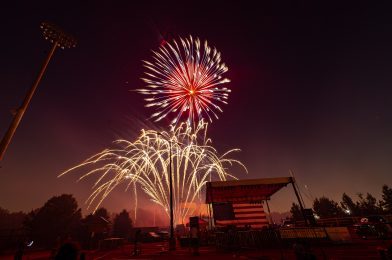Caption: Nikon D3S, 14-24mm, ISO 100, ƒ/8, 8 sec
Location, Location, Location
The success of a fantastic fireworks shot is the location. You need to know where the fireworks will go off well before they do.
You don’t want to try to line up your shot after they start. You can tweak your composition, but don’t be caught not knowing where they will go off.
Consider clear view verses using foreground or surrounding to help make your fireworks stand out. My favorite shots are those iconic locations in the foreground, like the Statue of Liberty or the Golden Gate Bridge in San Francisco.

Tripod and Cable Release
I recommend using a tripod and a cable release. This will keep the camera as still as possible during a long exposure.

This is the Nikon MC-30 that I have used for years on different Nikon Cameras.
Camera Settings
- Manual
- White Balance – Daylight
- ISO 100
- ƒ/8
- Bulb Shutter-speed and keep open for two bursts of fireworks using a cable release
My exposures were from 6 seconds to about 12 seconds on average. I typically might shoot 75 to 100 photos and only really like about 10 of those shots.

When to press the shutter? When you hear the boom of the fireworks, click the shutter and don’t let go until the end of the second fireworks. The bursting will create those beautiful shapes. You don’t get the same exposure if you shoot at faster shutter speeds. The reason is that as the bright fragments move, you capture them throughout the exposure, whereas the faster shutter speed would freeze them. This is similar to photographing car lights on streets at night. By letting the cars continue to move, you get a trace of the lights through the photo.


